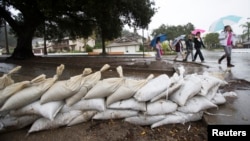A major Pacific storm that broke records across Southern California and delivered a small measure of relief to the drought-stricken state brought more rain on Wednesday but the danger of major mudslides in wildfire-scarred areas appeared to have passed, officials said.
The sub-tropical storm, which originated in the Pacific Ocean south of Hawaii, was the strongest to hit Southern California since at least February and poured at least an inch (2.5 cm) of rain across a wide swath of the region, and up to four inches (10 cm) in some mountain and foothill areas.
Rainfall records for December 2 dating to the 1960s were broken in downtown Los Angeles, Los Angeles International Airport, Long Beach Airport and communities such as Antelope Valley, Palmdale and Camarillo, National Weather Service meteorologist Eric Boldt said.
The storm also brought much-needed snow to area mountains.
Boldt said mudslides and flash floods that officials feared in areas where wildfires had left hillsides nearly barren did not materialize because rainfall rates generally remained below the half-inch-per-hour threshold that usually triggers them.
Evacuation orders that were issued for the wildfire areas were largely lifted by early on Wednesday.
California has been in the grip of a record-shattering, multi-year drought that has forced officials to sharply reduce water supplies to farms and prompted drastic conservation measures statewide.
Prior to Tuesday's storm, downtown Los Angeles had recorded a total of only 5.89 inches of rain for 2014, compared to the 15 inches the region receives in a typical year.
Boldt said the storm, the first of California's winter season that typically begins in December, was of some help in long-parched areas but would not be nearly enough on its own to ameliorate the drought.
“Every storm is going to help us but one storm is not going to get us out of the drought,” Boldt said. “If we have 10-20 more storms like this one we're going to be looking much better on the drought.”
The National Weather Service said the storm was expected to move out of Southern California to the east by the end of Wednesday, although a second, smaller system might bring showers to parts of the state on Thursday.







